Samsung did not miss their appointment. The South Korean company has just officially presented its family of high-end Galaxy S21 smartphones, and, as we could guess, the photographic features of these smartphones have taken up a good part of the time that the presentation has lasted.
If we stick to their photographic features, the Galaxy S21 and S21+ models are identical. Both have a single front camera complemented at the back of the device by three cameras in standard configuration (wide-angle, ultra-wide-angle, and telephoto lens).
However, the Galaxy S21 Ultra, which is the most powerful, adds to this distribution of cameras a second telephoto lens and a laser sensor that has the responsibility of assisting the autofocus. They look good, but so far we’ve only grazed the surface.
Samsung Galaxy S21, S21+, and S21 Ultra: Technical Specifications
| Galaxy S21 | Galaxy S21+ | Galaxy S21 Ultra | |
|---|---|---|---|
| Screen | Dynamic AMOLED 6.2″ FHD+ 2x 48-120 Hz | Dynamic AMOLED 6.7″ FHD + 2x 48-120 Hz | Dynamic AMOLED 6.8″ WQHD + 2x 11-120 Hz |
| Processor | Exynos Octa-Core 64-bit and 5nm lithography | Exynos Octa-Core 64-bit and 5nm lithography | Exynos Octa-Core 64-bit and 5nm lithography |
| RAM | 8 GB LPDDR5 | 8 GB LPDDR5 | 12/16 GB LPDDR5 |
| Storage | 128/256 GB | 128/256 GB | 128/256/512 GB |
| Front Camera | 10 megapixels, Dual Pixel technology, autofocus, f / 2.2 aperture value, 80º field of view and 1.22 µm photodiodes | 10 megapixels, Dual Pixel technology, autofocus, f / 2.2 aperture value, 80º field of view and 1.22 µm photodiodes | 40 megapixels, phase detection autofocus, 80º field of view, f / 2.2 aperture value and 0.7 µm photodiodes |
| Rear Cameras | – Wide angle: 12 megapixels, Dual Pixel technology, autofocus, 79º field of view, optical stabilization, aperture value f / 1.8 and 1.8 µm photodiodes – Ultra wide angle: 12 megapixels, 120º field of view, aperture value f / 2.2 and 1.4 µm photodiodes – Telephoto: 64 megapixels, phase detection autofocus, 3x optical zoom, 76º field of view, optical stabilization, aperture value f / 2.0 and photodiodes of 0, 8 µm | – Wide angle: 12 megapixels, Dual Pixel technology, autofocus, 79º field of view, optical stabilization, aperture value f / 1.8 and 1.8 µm photodiodes – Ultra wide angle: 12 megapixels, 120º field of view, aperture value f / 2.2 and 1.4 µm photodiodes – Telephoto: 64 megapixels, phase detection autofocus, 3x optical zoom, 76º field of view, optical stabilization, aperture value f / 2.0 and photodiodes of 0, 8 µm | – Wide angle: 108 megapixels, phase detection autofocus, 83º field of view, optical stabilization, aperture value f / 1.8 and 0.8 µm photodiodes – Ultra wide angle: 12 megapixels, Dual Pixel technology, autofocus , 120º field of view, f / 2.2 aperture value and 1.4 µm photodiodes – Telephoto lens 1: 10 megapixels, Dual Pixel technology, autofocus, 3x optical zoom, 35º field of view, optical stabilization, aperture value f / 2.4 and 1.22 µm photodiodes – Telephoto 2: 10 megapixels, Dual Pixel technology, autofocus, 10x optical zoom, 10 ° field of view, optical stabilization, f / 4.9 aperture value and 1.22 µm photodiodes – Autofocus by laser sensor |
| Sound | Stereo speakers equalized by AKG | Stereo speakers equalized by AKG | Stereo speakers equalized by AKG |
| IP68 Protection | Yes | Yes | Yes |
| Charge | Fast Wireless Charging 2.0 and USB PD 3.0 (PPS) certified fast charging for wired charging (AFC and QC2.0 compliant) | Fast Wireless Charging 2.0 and USB PD 3.0 (PPS) certified fast charging for wired charging (AFC and QC2.0 compliant) | Fast Wireless Charging 2.0 and USB PD 3.0 (PPS) certified fast charging for wired charging (AFC and QC2.0 compliant) |
| Security | Ultrasonic fingerprint reader, processor and security memory | Ultrasonic fingerprint reader, processor and security memory | Ultrasonic fingerprint reader, processor and security memory |
| Battery | 4000 mAh | 4800 mAh | 5000 mAh |
| Dimensions | 151.7 x 71.2 x 7.9 mm | 161.5 x 75.6 x 7.8 mm | 165.1 x 75.6 x 8.9 mm |
| Weight | 172 g | 202 g | 228 g |
| Price | $799 | $999 | $1,299 |
Samsung Galaxy S21 and S21+: Betting on a Traditional Camera Configuration
As you can see in the next picture, the distribution of the cameras of these two mobile phones is what we can currently consider standard, with the main module (wide angle) assisted by an ultra-wide-angle camera and a telephoto lens. What allows these smartphones to significantly differ from their predecessors is the metal sheet that protects the optics of each camera more consistently than the glass Samsung has used up to now, although its aesthetic impact is unlikely to convince everyone.
Wide-angle and ultra-wide-angle cameras use a 12-megapixel sensor, although their size is not the same. The photoreceptors of the main unit sensor are 1.8 µm in size, while the photodiodes of the ultra-wide-angle camera sensor are slightly smaller (1.4 µm). Also, the aperture value of the wide-angle camera is f/1.8, and, as expected, the optics of the ultra-wide-angle unit are less bright (f/2.2). One more point: the main camera incorporates optical stabilization.
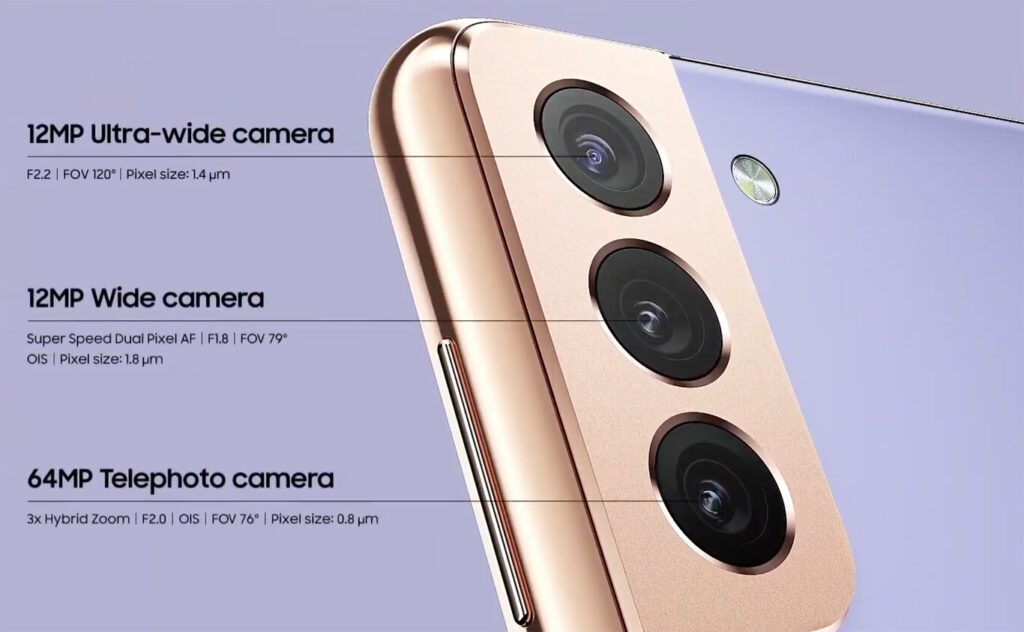
To solve the telephoto lens of these cell phones, Samsung engineers have opted for a 64-megapixel sensor that works in tandem with an aperture value of f/2.0 optics. The sensor’s photoreceptors are 0.8 µm in size, and, as befits this camera, it incorporates optical stabilization. The zoom offered without any digital processing is three times higher.
As we have just seen, the hardware of these three cameras seems to be well dimensioned, but this is only one of the components of the product. The other is the software. Samsung’s spokesmen have taken great pains during the presentation to emphasize how advanced their processing algorithms are and the artificial intelligence that is responsible for analyzing each of the captures in those shooting scenarios that require taking several images with different exposure.
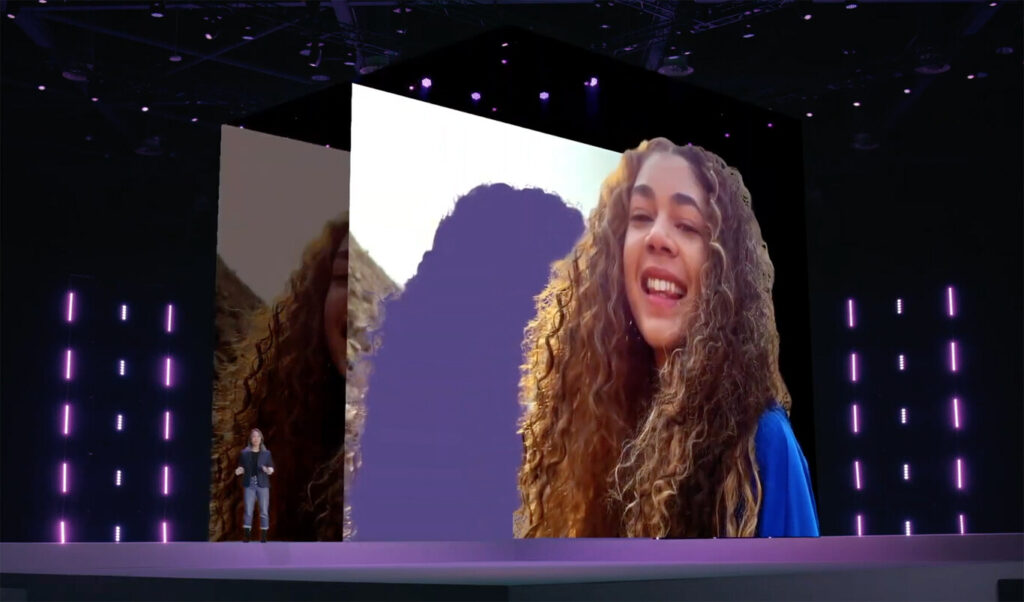
One of the biggest challenges that smartphones still have ahead of them is to implement a nice and homogeneous background blur that can accurately respect the contour of the subject or object placed in the foreground. These Galaxy S21s have a slider bar that allows us to act on the background blur to adjust its finish to our preferences.
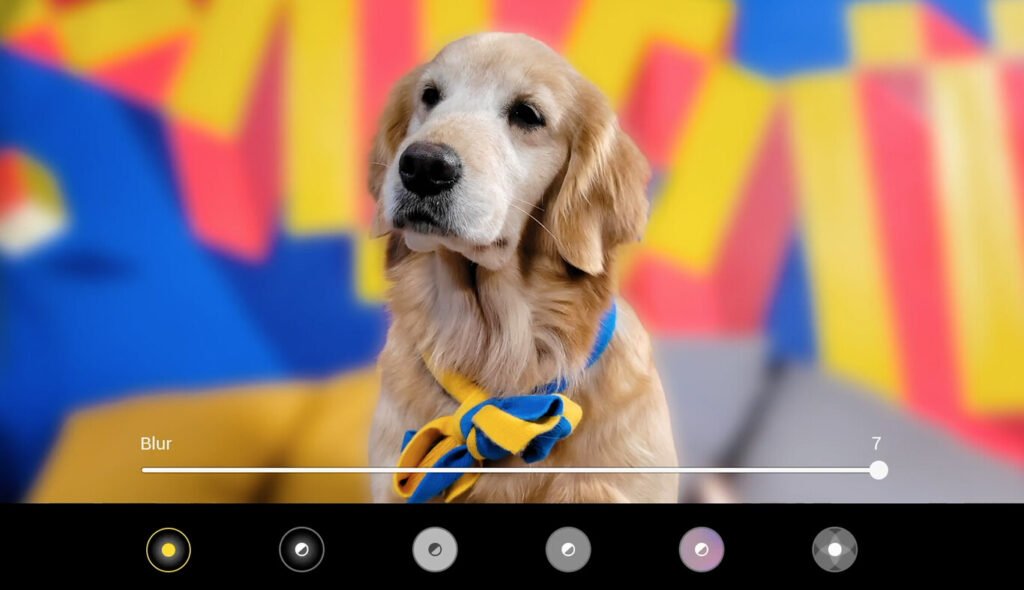
The space available inside smartphone limits sensibly both the size of the sensors and the complexity of the optics of each camera, so the software to a great extent acquires the responsibility of reaching where the hardware is not able to reach due to practical limitations.
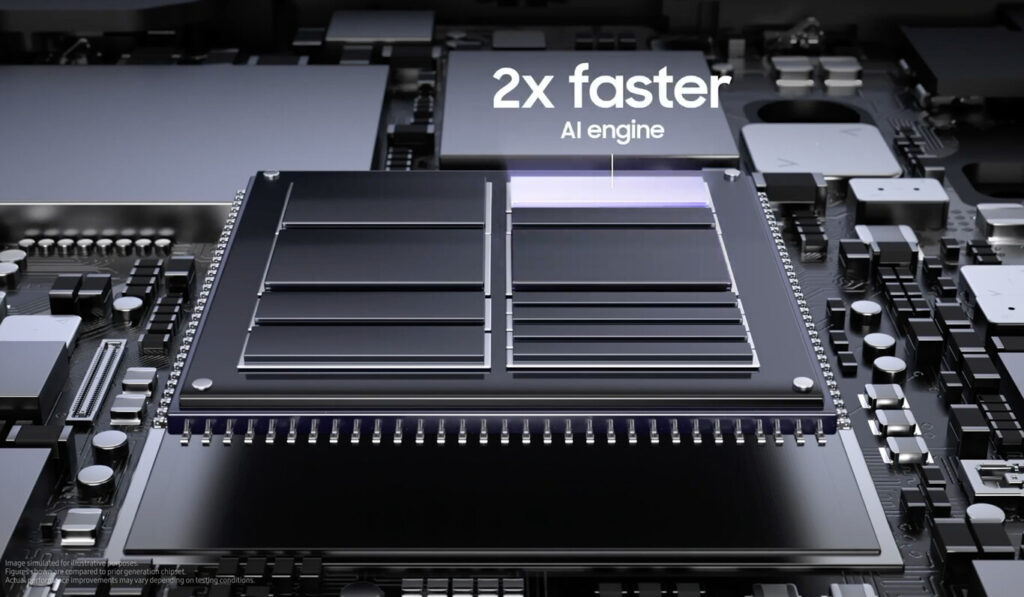
According to Samsung, the logic responsible for running the artificial intelligence engine in its new Galaxy S21 is twice as fast as that of the Galaxy S20, an improvement that should be perceived when the shooting conditions are not favorable and the processing algorithms must give the best of themselves. Of course, as soon as we have the opportunity to thoroughly analyze these cell phones we will share our impressions with you.
Samsung Galaxy S21 Ultra: two telephoto lenses and laser focus that makes the difference
The following snapshot leaves no doubt about how complex the optics associated with the high-end photo-oriented smartphone cameras can be. In this area, the Galaxy S21 Ultra is more powerful than its two range mates because it incorporates a second telephoto lens and a laser sensor that intervenes in the autofocus process to resolve it as precisely as possible in shooting scenarios where phase-detection focusing may be slow or inaccurate.
The main module of the Galaxy S21 Ultra, the wide-angle one, uses a 108-megapixel sensor with 0.8 µm photoreceptors that work side by side with an optic with an aperture value of f/1.8. It will be interesting to see how this camera performs when this device falls into our hands, and, in particular, how much detail this high-resolution sensor is capable of picking up.
The ultra-wide-angle camera incorporates a 12-megapixel sensor with Dual Pixel technology and 1.4 µm photodiodes that work in tandem with an optic with an aperture value of f/2.2. The field of view of this camera is 120°, and like all ultra-wide-angle modules, it faces the challenge of minimizing aberrations at the lens margins. To a great extent, distortion can be combated by developing higher quality optical elements, although software can also be a valuable ally in this field.
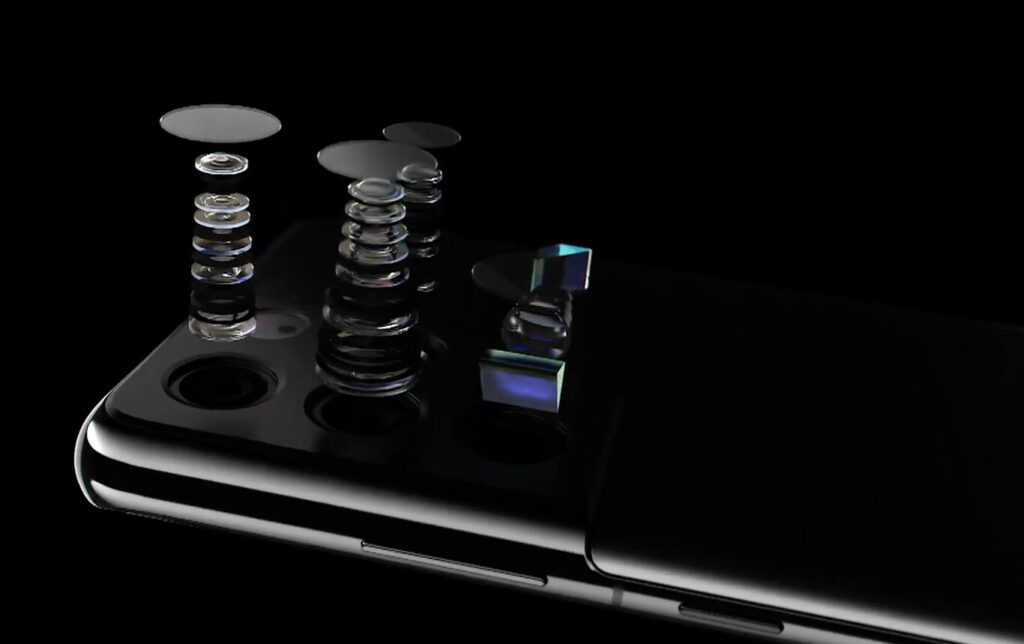
And finally, we come to telephoto lenses – why two? Samsung says that these two cameras have been designed to complement each other, so that one telephoto lens has been designed to effectively solve captures at medium focal lengths, and the other to work at longer focal lengths. The optical zoom of one of them offers 3X magnifications and the other 10X magnification.
Both telephoto lenses use a 10-megapixel sensor with Dual Pixel technology and 1.22 µm photodiodes. Another advantage they have in common is that they both have optical stabilization, as corresponds to a phone that is much more than 1000 euros. As expected, the differences between the two telephoto lenses lie in the optics, which, in addition to having a different composition of optical elements, also have a different aperture value: f/2.4 for the three-times magnification telephoto lens and f/4.9 for the 10X magnification.
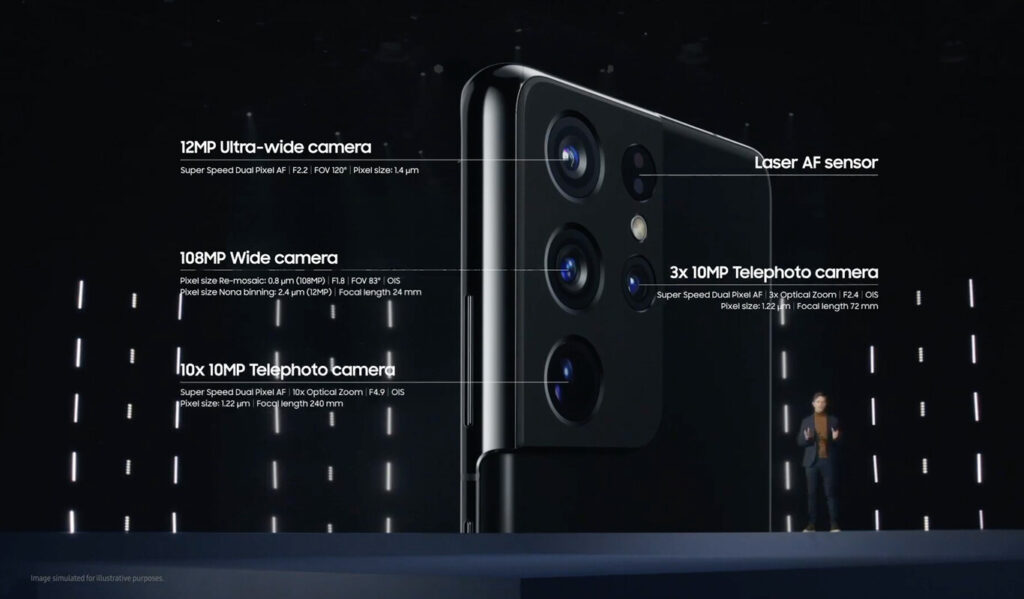
As in the other two Galaxy S21, software plays a critical role in this smartphone. Samsung has assured that its engineers have developed the most advanced artificial intelligence specialized in image processing to date so that this smartphone can successfully solve the most unfavorable shooting scenarios. Among other challenges, this component has the responsibility of eliminating noise and blur, two defects that can ruin many photographs.
Here are some additional interesting notes about this Galaxy S21 Ultra. According to the South Korean brand, the 108-megapixel sensor will allow us to take pictures with HDR, a 12-bit color depth, and a dynamic range three times greater than the other photographic mobiles of this brand.
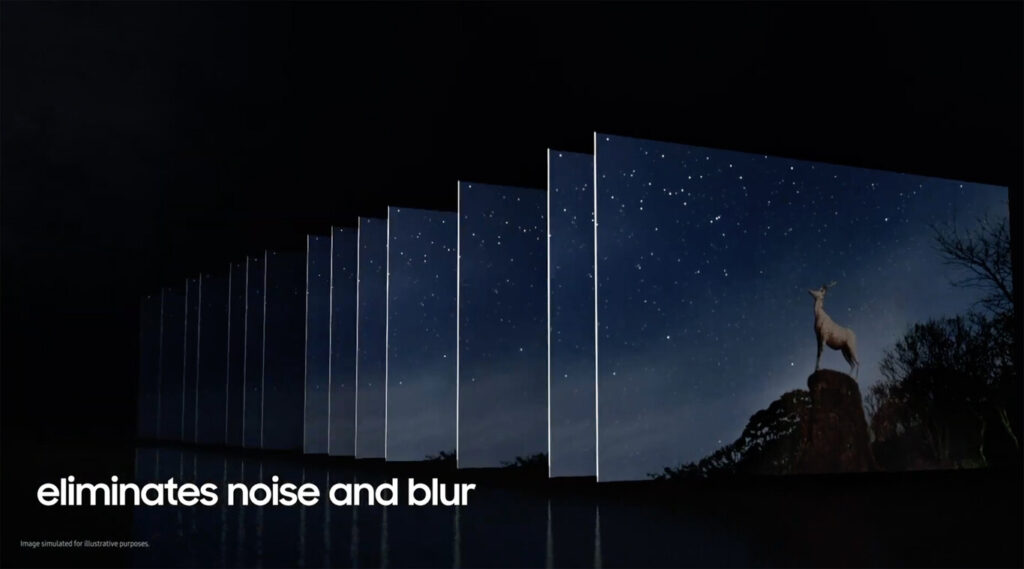
Also, the night mode has been refined by introducing improvements in both hardware and software to recover more detail and respect the original colors in the shots where there is a lack of ambient light. On paper, it doesn’t look bad at all, so we are looking forward to testing it thoroughly to find out if its performance lives up to the expectations Samsung has generated during its presentation.
Price and Availability
- The Samsung Galaxy S21 is available from today for a price starting at $799.
- The Samsung Galaxy S21+ is for those who want more screen and battery but don’t want to spend more than $999 of its initial price.
- The official starting price of this Samsung Galaxy S21 Ultra is $1,199, and it’s available from the 14th of January.
This post may contain affiliate links, which means that I may receive a commission if you make a purchase using these links. As an Amazon Associate, I earn from qualifying purchases.

